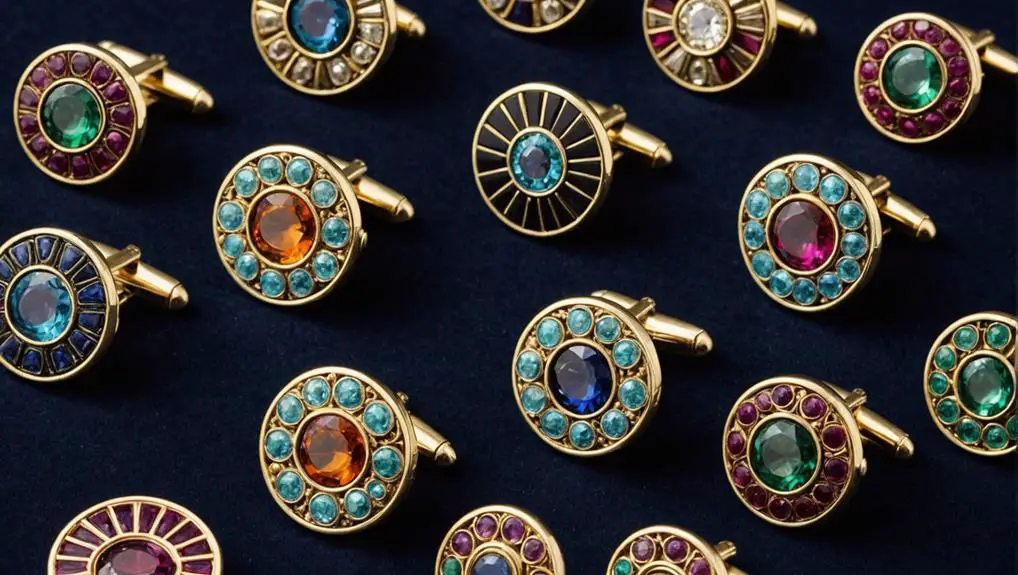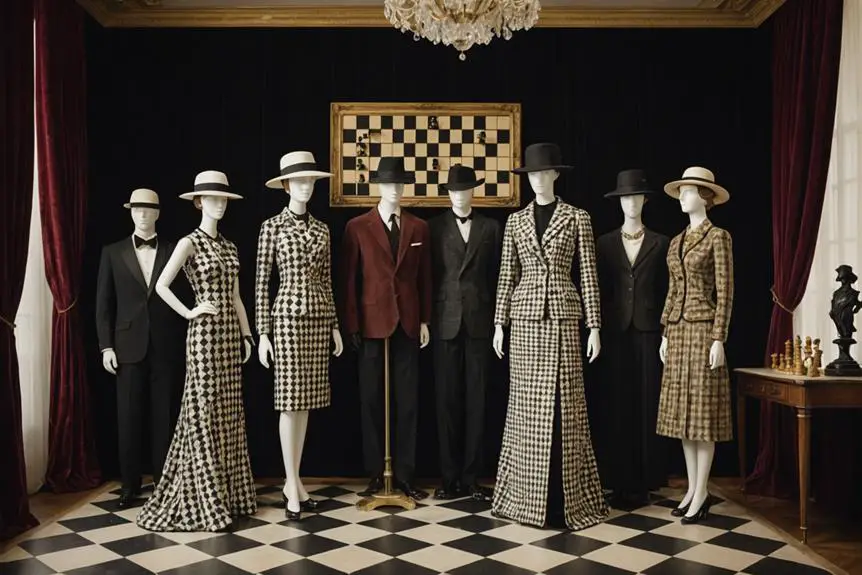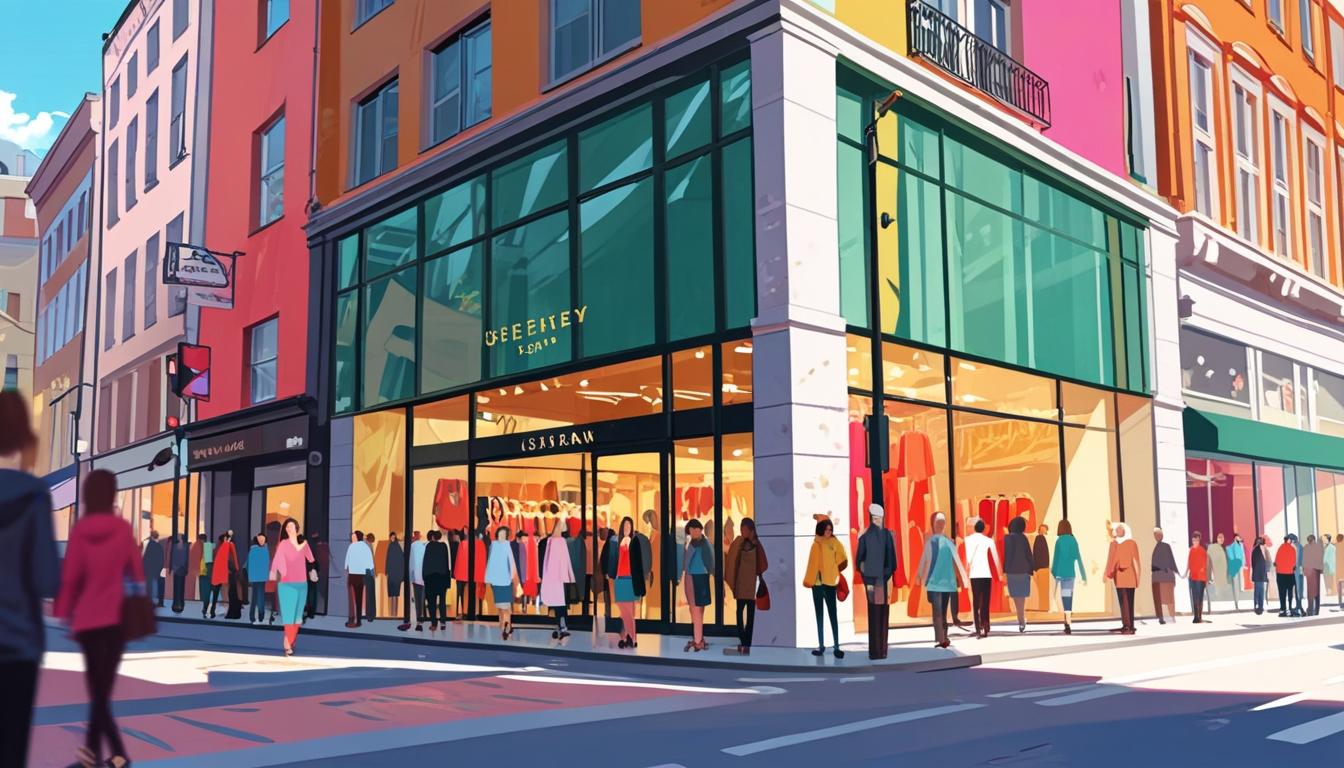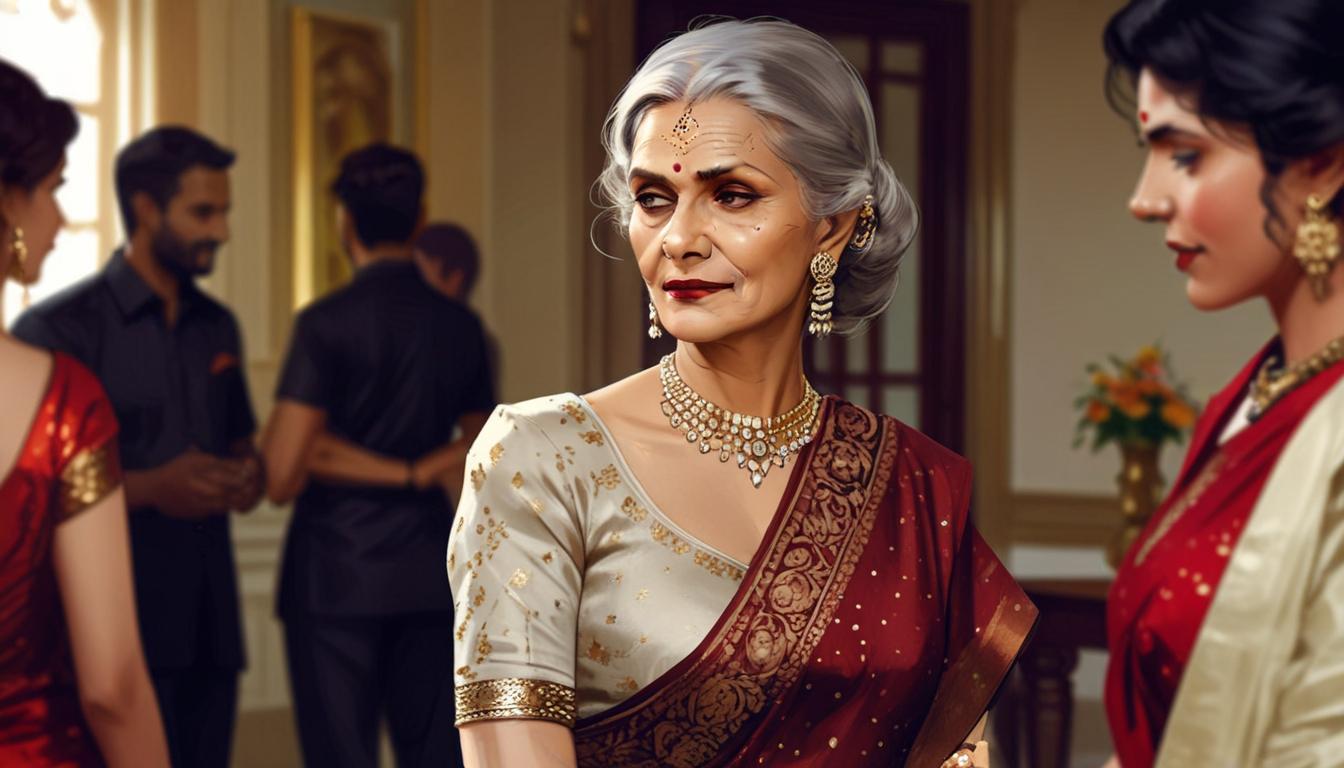In the 1920s, men's cufflinks evolved into essential fashion accessories that showcased the bold influence of the Art Deco movement. You'd notice their geometric patterns and vibrant colors, reflecting a newfound modernity and luxury. Designers like Tiffany & Co. and Cartier introduced intricate craftsmanship, using materials like gold, platinum, and striking colored enamels. Hand-fabricated techniques resulted in unique two-tone designs and decorative elements inspired by nature and Egyptian motifs. Major cities such as New York and London emerged as hubs for these fashionable items, with collectors increasingly valuing the historical significance and artistry behind them. There's much more to discover about this enchanting era.
Evolution of Cufflink Designs
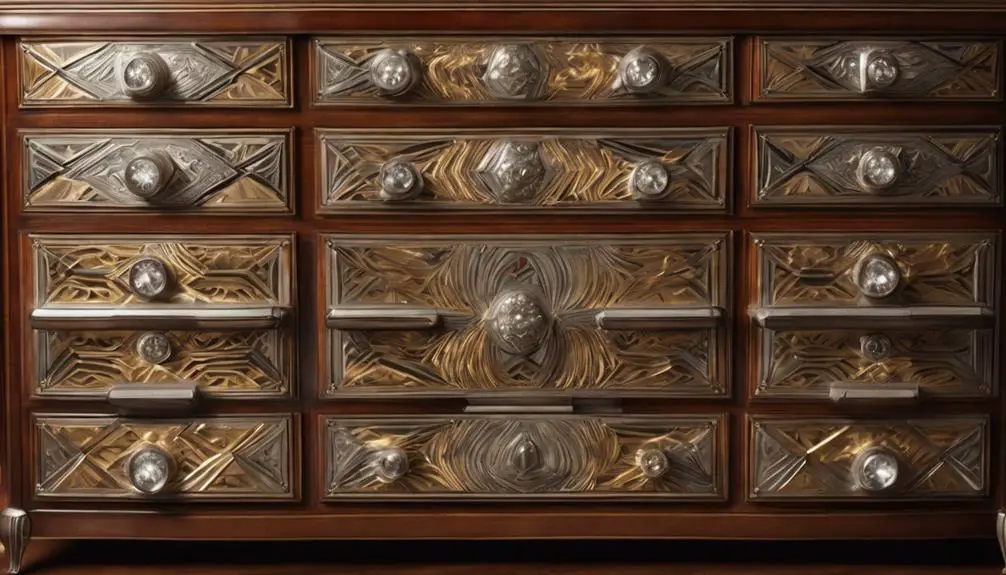
In the 1920s, cufflink designs underwent a remarkable transformation, largely influenced by the burgeoning Art Deco movement. You'd notice that mens cufflinks during this era embraced geometric patterns and bold colors, reflecting the spirit of modernity that defined the decade. Antique Art Deco pieces showcased intricate craftsmanship, often hand-fabricated, which made each cufflink a unique work of art.
The incorporation of colored enamels became a defining feature, particularly in pieces created by renowned brands like Krementz and Cartier. These vibrant hues not only added visual appeal but also highlighted the luxurious materials like gold and platinum that were widely used. The designs frequently drew inspiration from themes such as Egyptian Revival and nature, offering miniature motifs and dual-sided styles that captured the imagination.
As you explore the world of cufflinks from this era, you'll find that their unique designs and historical significance continue to attract collectors and fashion enthusiasts today. The evolution of Art Deco cufflinks marked a pivotal moment in men's fashion, transforming these accessories from mere functional items into essential expressions of style and sophistication.
Influential Designers of the Era
The 1920s' cufflinks not only reflect the artistry of the era but also the vision of influential designers who shaped men's fashion. Brands like Tiffany & Co., Krementz, and Cartier played pivotal roles, each bringing distinct craftsmanship to the table. Tiffany & Co. became renowned for intricate designs that often featured channel-set diamonds and exquisite enamel work, perfectly encapsulating the Art Deco aesthetic. Their creations were not just accessories but declarations of sophistication.
Krementz, on the other hand, carved out a niche with striking enamel cufflinks crafted from sterling silver, appealing to the fashion-forward men of the time. Their designs exuded a sense of modernity that resonated with the decade's spirit. Cartier, synonymous with luxury, showcased elegant cufflinks adorned with diamond and enamel accents. Significantly, their Art Deco enamel pieces from around 1925 stand as proof of their artistic innovation.
Additionally, J.E. Caldwell made waves by integrating sapphires and diamonds into their cufflinks, with some pieces dating back to 1922. These designers collectively contributed to a fashion landscape where cufflinks became essential elements of a well-dressed man's ensemble, reflecting both personal style and the vibrant culture of the 1920s.
Art Deco Style Characteristics
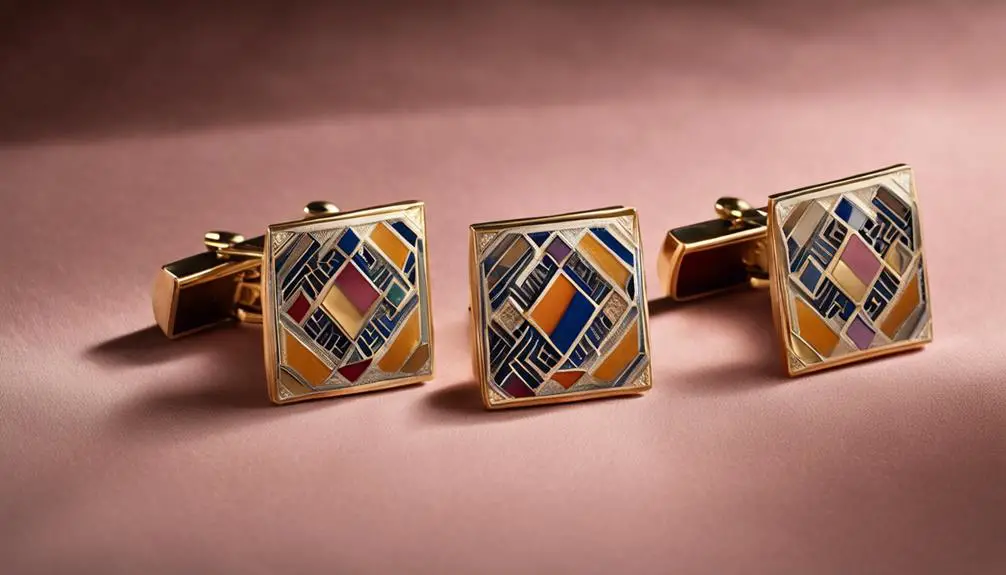
While exploring the dazzling world of Art Deco cufflinks, you'll notice their defining characteristics that perfectly capture the essence of the 1920s. This style is marked by geometric patterns and bold colors that evoke the opulence of the era. Cufflinks for men from this period often feature intricate designs inspired by Egyptian Revival themes and nature, showcasing a fascination with exoticism and elegance.
You'll find that many Art Deco cufflinks incorporate luxurious materials like 18K gold, platinum, and sterling silver. The use of enamel and diamond embellishments adds a striking touch, enhancing their appeal. Unique features such as guilloche patterns and two-tone designs create depth and texture, making these pieces highly sought after by collectors.
The innovative design and high-quality materials in Art Deco cufflinks not only reflect the craftsmanship of the time but also contribute to their lasting popularity. Today, vintage fashion enthusiasts continue to appreciate these exquisite adornments, which embody the spirit of an era defined by glamour and sophistication. Whether you're drawn to the elegance of enamel silver or the allure of diamond platinum, Art Deco cufflinks remain timeless treasures in men's fashion.
Materials and Craftsmanship
Craftsmanship in 1920s cufflinks reflects a remarkable blend of artistry and luxury, showcasing the era's commitment to fine details. During this time, you'd find cufflinks crafted from opulent materials like 14K, 18K, and 9ct gold, along with sterling silver and platinum. This selection not only highlighted the wealth of the wearer but also the skill of the artisans behind these exquisite pieces.
Intricate hand-fabrication techniques defined the craftsmanship of the period, resulting in cufflinks adorned with decorative elements such as guilloche patterns and vibrant colored enamels. You might encounter designs that incorporated onyx, diamond, rock crystal, and mother of pearl, enhancing their elegance and allure.
The Art Deco movement heavily influenced the aesthetics of the time, promoting geometric patterns and bold color contrasts that resonated with the luxurious vibe of the decade. Furthermore, many cufflinks featured dual-sided designs and miniature motifs, emphasizing the meticulous attention to detail that set these accessories apart. This unique blend of materials and craftsmanship not only elevated men's fashion but also marked a significant moment in jewelry design history.
Geographic Market Trends
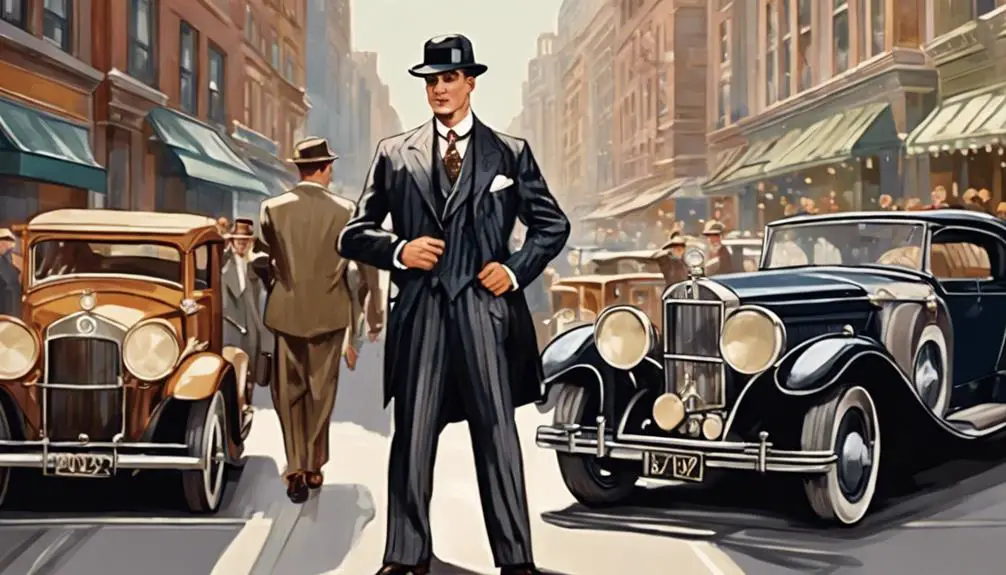
Cufflinks from the 1920s not only reflected individual artistry but also showcased distinct geographic market trends that influenced their design and availability. Major cities like New York, London, Chicago, and Miami emerged as pivotal hubs for vintage cufflinks, each contributing unique styles that captured the essence of the Deco and Art movements. In New York, you'd find luxury cufflinks that emphasized bold geometric designs, appealing to the affluent elite enthusiastic to showcase their sophistication.
London stood out as a critical center for high-end cufflinks, featuring exquisite collections from prestigious brands like Tiffany & Co. and Cartier. As you explored the market, you'd notice that cities such as Melbourne and Paris also began to flourish, offering cufflinks characterized by unique craftsmanship and exceptional materials.
The pricing spectrum for these vintage cufflinks varied widely, catering to both collectors and fashion enthusiasts. With approximately 120 cufflinks available for sale on platforms like 1stDibs, there was something for everyone. Many listings even included free shipping options, enhancing the appeal of these luxury cufflinks and ensuring their place in the fashionable man's wardrobe during the roaring twenties.
Collecting Vintage Cufflinks
There's a growing fascination among collectors for vintage cufflinks from the 1920s, particularly due to their striking Art Deco designs that feature geometric patterns and luxurious materials like gold and platinum. Collecting these pieces isn't just about style; it's also an investment in history and craftsmanship. Notable brands like Tiffany & Co., Cartier, and Krementz are prized for their exquisite workmanship, often incorporating diamonds and colored enamels into their designs.
When you examine the market, you'll find a diverse range of options. Prices can vary greatly, reflecting the intricacy of the cufflinks and the materials used.
| Material | Price Range | Examples |
|---|---|---|
| Silver | $10 – $300 | Art Deco Sterling Silver |
| Yellow Gold Cufflinks | $200 – $800 | Cufflinks signed by Tiffany |
| Pearl Cuff Links | $50 – $400 | Vintage designs with pearls |
As you investigate this collecting journey, pay attention to detailed descriptions of materials and condition, as these factors can greatly influence a piece's value. Online platforms like 1stDibs make it easier to find unique additions to your collection.
Frequently Asked Questions
Did Men Wear Cufflinks in the 1920s?
Yes, men did wear cufflinks in the 1920s. These accessories complemented formal attire, showcasing luxurious designs and high-quality materials. Their popularity reflected a broader fashion trend emphasizing elegance and sophistication in men's clothing during that era.
When Did Men Start Wearing Cufflinks?
Men started wearing cufflinks in the late 17th century, evolving from simple fastenings to decorative accessories. By the 18th century, their popularity soared, making them essential for stylish attire across Europe's elite.
What Do Cufflinks Say About a Man?
Cufflinks reveal your sophistication and attention to detail. They signal your appreciation for craftsmanship and personal style, showcasing your confidence and social status, especially during formal events where elegance and uniqueness are paramount.
What Was the Purpose of Cufflinks?
Cufflinks serve a dual purpose; they fasten your shirt cuffs securely and elevate your style. Their intricate designs and luxurious materials reflect your taste, showcasing your attention to detail and appreciation for elegant accessories.
